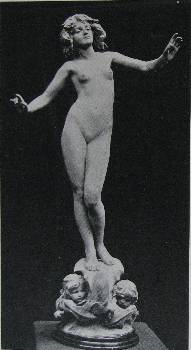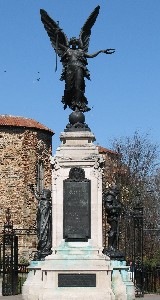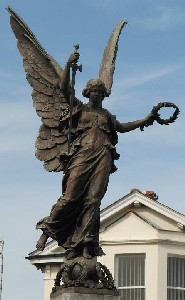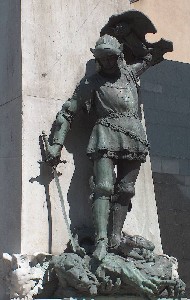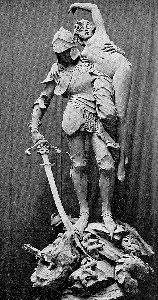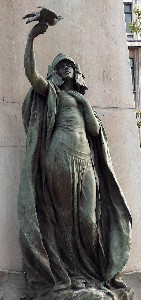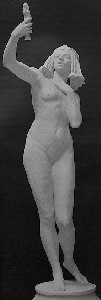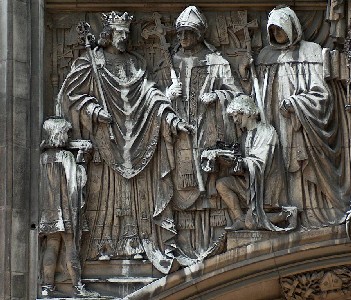Henry Charles Fehr (1867-1940)
Fehr's Spirit of the Waves.
The sculptor Henry C. Fehr, a leading member of the New Sculpture movement, is best known for his statues of dreamy Symbolist girls. He was successful in winning a number of commissions for World War I memorials, portrait statues, and a variety of decorative architectural sculpture.
The sculptor H. C. Fehr was born in Forest Hill, in north-east London. He attended the Royal Academy Schools from 1885, ‘taking all the prizes that were to be taken’ in the words of the eminent art critic Spielman, and from 1889-93 was studio assistant to the sculptor Thomas Brock. During this time he produced his important work Perseus Rescuing Andromeda (1893), bought under the terms of the Chantrey Bequest in the following year. Fehr specialised in monuments and architectural sculpture, and ideal allegorical nudes, with titles such as Aphrodite, Spirit of the Waves, Morning and so on. He also designed coloured bas reliefs for interior decoration.
Stylistically, Fehr is very much part of the New Sculpture movement, and in particular his girls tend to an ideal art nouveau or Symbolist style, with very beautiful faces, and rich in allegory. In clothing he tends to the Gothic, the decorative, and detail in ornament, and for his knights, spiky armour in the fashion of Alfred Gilbert. Both his males and female ideal creations have a certain appealing decadence.
Colchester War Memorial and close up of Eastbourne's Angel of Victory.
Outdoor ideal statues by Fehr include a series of closely related war memorials. The one in Colchester is the type model – a winged bronze Angel of Victory on a raised stone column, carrying a wreath, and a down-pointing sword to show the cross. flanked by a figure of Peace – a girl holding a dove, and St George, in armour, with sword and shield, standing on the top of a dragon’s head, loosely rendered. In Burton on Trent, according to photos on the web (I have not seen the original) we have seemingly the identical ensemble. The Leeds version has lost the statue on top (it has been replaced with an excellent modern statue by Ian Judd, a Leeds sculptor), the same version of Peace, and a variation of the St George figure, stabbing the complete, rather smallish dragon underfoot. In Eastbourne, we have just the Angel, identical in pose to that in Colchester. Ditto in Lisburn (Northern Ireland), Lockerbie, Grangemouth, and Langholm, Dumfries.
Leeds St George and St George and the Rescued Maiden.
The St George figure, atop the dragon is similar to Fehr’s much earlier St George and the Rescued Maiden (1898), with the nude girl contrasting to the warrior’s fantastical armour. The Peace figure relates to a figure from the year before that, a nude entitled Invocation to the Goddess of Love (by way of comparison, if completely off the point, these pages include one on allegorical statues of Love).
Leeds Peace and Invocation to the Goddess of Love.
Moving to other sculpture by Fehr, we should note the important bronze Perseus Rescuing Andromeda standing on the right hand balcony outside the main entrance of Tate Britain, facing the Clore Wing. He made a very spiky dragon for the summit of the Cardiff City Hall dome. Fehr’s also is the extensive sculptural work on the Supreme Court (former Middlesex Guildhall), in Parliament Square and the four terra cotta Queens adorning the exterior of the Russell Hotel, Russell Square. He made bas reliefs, showing the Wars of the Roses, for Wakefield Town Hall.
Finally, we must note Fehr’s portrait statues. In Hull is a statue by Fehr of Queen Victoria, with two allegorical girls flanking her pedestal. In Leeds City Square are James Watt (1898) and John Harrison (1903), in Aylesbury the noble John Hampden, and in Bradford, in Cartwright Hall, the seated figure of Cartwright (1902). Among portrait busts, we may mention William Morris in the William Morris Gallery in Walthamstow, satisfying given the sculptor’s link with north-east London, and Passmore Edwards, the philanthropist linked particularly with various London libraries and galleries.
A few more statues by Fehr are shown on this page.
Figures from the Supreme Court building.
